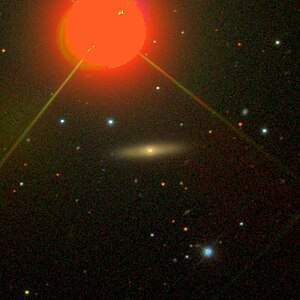IC 1208
| Galaxy IC 1208 |
|
|---|---|

|
|
| SDSS recording | |
| AladinLite | |
| Constellation | Northern crown |
|
Position equinox : J2000.0 , epoch : J2000.0 |
|
| Right ascension | 16 h 15 m 47.9 s |
| declination | + 36 ° 31 ′ 38 ″ |
| Appearance | |
| Morphological type | S0 / a |
| Brightness (visual) | 14.4 mag |
| Brightness (B-band) | 15.3 mag |
| Angular expansion | 1 ′ × 0.2 ′ |
| Position angle | 95 ° |
| Surface brightness | 12.5 mag / arcmin² |
| Physical data | |
| Affiliation | Abell 2199 |
| Redshift | 0.032242 ± 0.000077 |
| Radial velocity | 9666 ± 23 km / s |
|
Stroke distance v rad / H 0 |
(438 ± 31) · 10 6 Lj (134.4 ± 9.4) Mpc |
| history | |
| discovery | Sherbourne W. Burnham |
| Discovery date | May 20, 1890 |
| Catalog names | |
| IC 1208 • PGC 57650 • CGCG 196-016 • 2MASX J16154791 + 3631378 • GALEX ASC J161547.93 + 363138.6 • LDCE 1184 NED002 | |
IC 1208 is a lenticular galaxy of the Hubble type S0 / a in the constellation Corona Borealis in the northern sky . It is an estimated 438 million light years away from the Milky Way and about 130,000 light years in diameter.
The galaxy NGC 6104 is located in the same area of the sky .
The object was discovered on May 20, 1890 by Sherburne Wesley Burnham .
